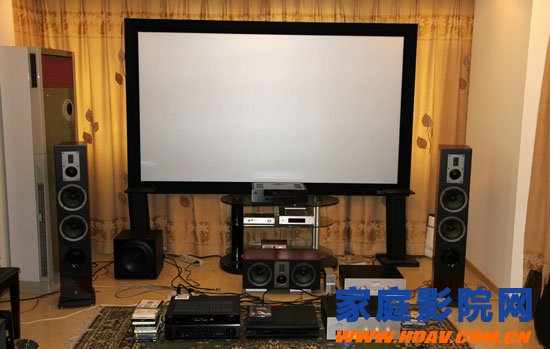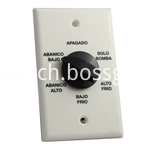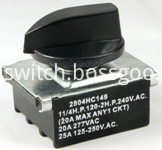[Home Theater Network HDAV.com.cn] The noise caused by the ground line accounts for most of the noise of the sound system, but the noise is not caused by the ground line. There is still noise even if all power wiring is OK. The front and rear stages are not properly matched, the front and rear stage transformers are shielded, and so on, and noise may be generated. And if the speaker sensitivity is too high, no noise can be avoided in any av preamp. The hifi pre-level noise control is relatively good.

It is often argued that this problem is caused by the noise floor of the active speaker. The noise is from the power amplifier. Some people say that one meter can hear the noise is normal. Some people say that 10 cm can hear the noise is normal. In fact, one meter is also known. Well, the short point is also longer or longer. It is not necessary to be true. This is not accurate. The reason is very simple. Distance is not the only factor that affects judgment. There is also the hearing quality of each person, which in turn affects the distance.
What I want to explain is that
Some people don’t know that all sounds have noise.
Large or small,
It is only a problem when the noise floor is so large that it affects listening to music.
In fact, these troubles are mainly caused by ordinary people who don’t know much about sound.
How to take this problem seriously?
Just look at the instructions for these large or small active speakers to see a parameter ------ power amplifier signal to noise ratio.
I will roughly describe the signal to noise ratio.
If it is 60 to 70db, then the noise can be heard from two meters away.
If it is 70 to 80, it is almost one meter.
80 to 90 or even higher, that is half a meter to tens of centimeters or even posted to be heard.
The above situation is during the day, and if it is late at night, the distance that can be heard is even further.
First, the above is the volume knob position under the normal listening volume, that is, the volume potentiometer is about 10:30, not letting you turn the volume knob to the head, in which case the noise is several times larger.
In addition, my metaphor is not very accurate, because each person has different hearings and may have an error of 3 to 6 db. Moreover, the noise floor of the system is not only related to the signal-to-noise ratio of the power amplifier, but also related to the sensitivity of the speaker. However, if I am too complicated, I am tired and you are tired.
Another point is that the noise floor is similar to the buzz of the radio signal blind zone, rather than the hum of the bristles. The latter is indeed a problem with the power supply circuit or the power supply in the environment.
In audio systems such as recording and live sound reinforcement, the noise problem is a ubiquitous and very headache problem. The more the sound system is composed, or the longer the transmission distance, the greater the background noise of the system, and even the sound. The system can't perform normal recording or sound reinforcement work, and the mechanism of sound system noise formation is more complicated. Now we analyze and discuss the main causes and solutions of noise of these sound systems.
1 Causes of noise
Spurious electromagnetic radiation interference in the environment, such as high-frequency electromagnetic radiation interference of communication equipment such as mobile phones and walkie-talkies, electric pulse radiation such as elevators, air conditioners, automobile ignition and electric welding in the surrounding environment, lighting control in the studio, and thyristor rectifier control equipment The generated radiation will be directly mixed into the transmission signal through the audio transmission line to form noise, or the casing of the poorly shielded device will interfere with the internal circuit to generate interference noise. Practice has shown that in some special occasions, such as the use of large quantities of thyristor In the studio of optical equipment, if no reliable shielding and grounding measures are taken, the noise will be very serious.
2 power interference noise
External interference of audio equipment, in addition to electromagnetic radiation, the introduction of interference noise in the power supply will be another main cause of noise. The urban power grid has formed a very serious problem due to the joint access of various lighting equipment, power equipment and control equipment. Source of interference. If the lighting control equipment, air conditioner, motor, etc. connected in the same power grid will generate the Jianfeng pulse, the surge current, the ripple voltage of different frequencies on the power line, and the power supply of the audio equipment will be broken through the power line. A part of the interference noise can not be effectively filtered out by the power supply circuit of the audio equipment, and noise will be formed inside the equipment, especially the high-power equipment in the same power grid that does not meet the requirements of electromagnetic compatibility, which is the main reason for interference with the audio equipment. .
3 Ground loop noise
In the sound system, the whole system must be grounded well, and the grounding resistance is less than 4 ohms. Otherwise, the induced charge generated by the various radiation and electromagnetic induction of the equipment in the sound system will not flow into the earth, thus forming a noise voltage superimposed on In the audio signal.
If there is a ground potential difference between the grounding resistances of different devices due to the difference in grounding resistance, or if there is a loop in the internal ground of the system, ground noise will be caused. When two different sound systems are interconnected, there is also the possibility of noise, which is directly caused by the ground of the two systems.
There is a relatively simple processing method. The metal piece in the middle of the three-eye power cord plug is wrapped with a transparent tape or an electrical tape to achieve the shielding and breaking effect, and the ground loop noise of some users can be eliminated. Some users who cannot be eliminated should continue down. Look in detail.
4 circuit noise inside the device
Audio equipment has an indicator - signal to noise ratio. Due to the electrical noise generated by internal electronic components, the required specifications can be achieved in a single device, but when multiple machines are connected, the noise will increase cumulatively. In practical applications, some low-end civilian audio equipment will have a large humming sound due to poor internal internal power supply filtering, and sometimes a very serious noise is formed in the sound system.
Correct connection of the system
In an audio system, there are many devices that are generally used, both professional and civilian. Different devices have different interface forms, and the connectors used are different. The balanced and balanced input and output are also used. form. In order to effectively shield the external electromagnetic radiation interference, it is necessary to use the shielded cable uniformly and connect it in the correct way. We know that when the audio signal transmission adopts the balanced transmission mode, the external interference source pairs the two signals in the balanced cable. The common mode interference level generated by each line of the line is almost equal to the ground loop. At the input of the internal amplifier of the device, the common mode voltage drop on the two signal lines is replaced by the differential mode voltage and cancel each other, forming an interference voltage. , so you should use a balanced connection as much as possible.
When connecting with some unbalanced output devices, most of them are now cost-saving and convenient, and the single-core shielded cable is used to connect the balanced ports and the balanced ports without using a balanced-unbalanced variator. The connection shield is also in the audio loop. The noise induced by the shield is also mixed into the audio signal, which increases the noise. This will be the main way to introduce noise. The correct approach is to balance and unbalance the transmission. Both use a double-core shielded cable, where the shield is grounded only at the end of the balanced output or input.
When both ends are unbalanced devices, if the transmission distance is large, it is best to use a balun or an audio isolation transformer to convert to balanced transmission.
Nowadays, the connection of audio equipment is generally connected by voltage. It is factory-compliant with the IEC268-15 standard, that is, the line output of the audio equipment is low-impedance output, and the line input end of the load is high impedance. Input, in addition to the connection of the amplifier and the speaker, generally do not need to specifically consider the impedance problem.
Good grounding
We know that in order to shield the external stray electromagnetic interference with a shielded cable, the shield must have the correct connection and good grounding. In practice, all equipment is suspended, without any special ground wire. A commonly used measure, which is a very unstable working condition, often produces unstable random noise, so the entire system must be well grounded.
First of all, there must be a special ground wire. The grounding resistance is less than 4 ohms. The neutral wire of the power supply cannot be used as the ground wire of the audio system equipment. In the special recording and sound reinforcement places, the ground wire specially laid in the construction is considered. The grounding resistance is very small. In temporary indoor places where there is no special ground line, you can use a water pipe or a heating pipe to connect the ground wire. However, since the grounding resistance of the iron pipe is often too large, such a ground wire has a certain effect but the effect is not good. Outdoor sites can be considered for embedding temporary ground lines. The easiest way is to insert a one-meter-long steel pipe or aluminum alloy pipe into the ground, which can achieve good results.
The general sound system is a link system that is connected with multiple audio equipments through audio cables. It is easy to form a chain grounding method by its shielding system. When electromagnetic radiation or static induction noise is generated on a certain equipment, it will be When the internal resistance of the grounding system composed of the shielding layer of the transmission line and the grounding system of the iron equipment casing is high, the charge balance speed of the whole system is slow to generate an induced voltage, and the induced voltage can cause the system to generate a certain noise level. Such interference is especially noticeable in long-distance audio systems, so the system should be avoided as much as possible, using chain grounding, and star grounding should be used, that is, each device is connected to a unified grounding point through a special grounding wire. In this case, the shield of the audio cable connecting all the devices is grounded (connected to the shield), and the wires of each device are connected to a ground point (usually near the mixer) through a dedicated wire.
It is necessary to pay attention to the formation of the loop. If the shielding layers at both ends of the signal transmission line are grounded, a ground loop must be formed. Because the large coil formed by these closed loops is inductive current when it is interfered by the electromagnetic radiation of other equipment, the induced current When it appears on the shielding system, especially when it appears on the shielding layer of the audio cable, it will inevitably produce severe dry high noise and form ground loop noise interference.
In order to ensure that the system does not have the structure of the ground loop, only one grounding conductor can be interconnected between the devices. The unbalanced connecting device cannot be connected to the shielding layer at one end, and can only be connected by ground. At this time, only the conversion mentioned above can be used as the balanced transmission method. In the case where the requirements are not strict, the unbalanced equipment can be suspended, and the grounding line of the next-level equipment is shared by the audio signal line, that is, the chain grounding is adopted. The number of stages of this chain grounding should not be too much, generally no more than two levels, otherwise the noise will increase severely.
Connection problems between enclosures should also be noted, such as many audio equipment installed in the same rack. If each device is connected to a ground wire separately, the two devices can be connected because they are mounted on the same rack, thus forming a ground loop.
Purification of power supply
In order to isolate the interference noise formed by the public power grid, it is better to use an isolated clean power supply or an isolation transformer. The grounding end of the isolation transformer or the clean power supply must be well grounded. Otherwise, the isolation effect is not good, and some high-power electrical appliances with strong interference should be used. Isolation, power supply alone, or a filter at the power input of the audio device filters out interference noise.
Sometimes by changing the two-stage l, n insertion and swapping of the single-powered audio equipment, that is, the section where the live line and the neutral line are connected to each other, to find the one with the least noise, or some noise interference. Lower, also pay attention to the audio transmission line can not be paralleled with the power line wiring, it is also possible to generate AC induction noise, the audio line and power line cross wiring, can also reduce AC noise interference.
System isolation
In some large-scale audio systems, there are often multiple console-centered subsystems, either connected to the video equipment system and sometimes to remote audio and video systems. Radio stations even use audio lines to transmit audio broadcast live signals. These long-distance connections, because different subsystems have their own independent grounding systems, the two systems once connected to the ground, otherwise ground noise is formed, on the other hand, due to transmission The distance is long, the grounding resistance of the transmission line shielding layer is increased, and even if an unshielded transmission line is used, it is easy to introduce a large amount of external electromagnetic field radiation to interfere with noise.
In practice, if each system works alone, the noise can be controlled at a permissible level through reasonable wiring and grounding, but when the two subsystems are interconnected, it is not well controlled, ie, single-ended shield grounding, long-line is used. There is no way to solve the radiated interference noise caused by long-distance transmission. Especially when using a large telephone network transmission, the signal that can not be transmitted can not be used. This is the best measure to isolate the two systems by installing an isolation transformer between the two systems. The wires of the system cannot be connected.
More fresh and fun home theater information, please pay attention to home theater network http:// (WeChat: cnhifi), the country's most influential home theater audio player interactive media website.
Note: The author: WENTINS sound. The article is an independent view of the author and does not represent the position of the home theater network.
Kara offers a range of Rotary Switches.Ranging from 5 to 9 poles,15VA to 25 amp,with many choices of functions,especially the switches with High-Current .Certifications include CSA, CE, and more.
This item used very in the line of cooler,with metal panel or plastic panel or only switch are all available.



Rotary Switch,Rotary Switch Knobs,Rotary Switch 6 Position,Mini Rotary Switch
Ningbo Kara Electronic Co.,Ltd. , https://www.kara-switch.com
